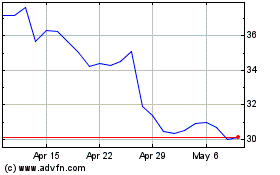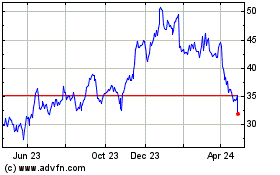Intel Chief Reinforces Upside of Paranoia -- WSJ
May 09 2020 - 3:02AM
Dow Jones News
By Asa Fitch
This article is being republished as part of our daily
reproduction of WSJ.com articles that also appeared in the U.S.
print edition of The Wall Street Journal (May 9, 2020).
Intel Corp. Chief Executive Bob Swan has seen his workforce
renew the get-to-it spirit embodied in the "only the paranoid
survive" maxim coined by the company's former CEO Andy Grove.
Mr. Swan's next challenge is to keep the momentum going after
the coronavirus pandemic's intense influence on business fades.
"It forces us to step back and ask ourselves, how is it in
moments of crisis we are able to get so much done so fast?" he told
The Wall Street Journal. "How do we continue that pace in a more
normal environment?"
Mr. Swan, Intel's boss since 2018, is seeking a more efficient
way of operating at a tech behemoth. The chip maker has more than
100,000 employees spread across 46 countries. It takes multiple
layers of management to keep it running.
Intel's future will include allowing managers under the CEO to
have more direct decision-making responsibility -- something Mr.
Swan had been pushing before the pandemic, but has gained speed
since.
He has been encouraged by the way lower-level managers have
often eschewed approval from superiors for important decisions that
couldn't wait. He's already looking at ways to cut out red tape
permanently.
"I think sometimes we forced them to come and ask for
permission, but hey, if you know the right thing to do, just go do
it. And we'll figure it out later," he said.
The company's response to this crisis drew on lessons learned
more than 15 years ago, during the SARS epidemic. A Pandemic
Leadership Team was put together in the aftermath of that crisis,
and was reconvened to deal with the coronavirus.
Mr. Swan's path forward is informed by the problems that Intel
encountered during the pandemic, and how the company's structure
and processes responded to address them.
For instance, as the pandemic spread, many customers ordered
more chips for PCs that were in high demand as employees shifted to
working from home. Cloud-computing giants, including Amazon.com
Inc. and Microsoft Corp., also wanted more chips to cater to
growing demand in the work-from-home economy.
This increase in demand coincided with much of global air
transport being grounded, making moving goods around the world a
logistics challenge that constantly evolved. Intel also had to
negotiate to keep its factories running after many governments
where it operates -- including its hometown of Santa Clara, Calif.
-- closed nonessential businesses.
Intel managers had a head start as they were already dealing
with upheaval due to a shortage of Intel processors. A war room was
set up in November, even before concerns about a new coronavirus
surfaced.
That room morphed into a hub for addressing pandemic-related
supply-chain issues in the months to come. The team participates in
twice-daily meetings, three days a week. One of their tasks:
keeping activities of its roughly 16,000 suppliers in sync with
those of 2,100 customers who typically place about a million orders
a year -- something that can be a challenging even in stable
times.
Seeing a limited availability of commercial flights to move
items, executives signed off on chartering planes to move parts
within Intel's globe-spanning manufacturing footprint. The flights
moved goods between warehouses and other facilities in Vietnam,
Hong Kong, China and Japan.
To keep factories humming, stockpiles of raw materials needed
for chip-assembly and testing operations were increased by at least
30 days, while spare-parts inventories at chip factories were
extended to 45 days' worth.
Engineers, meanwhile, are now using remote digital access to
labs to continue research projects.
Mr. Swan leaned on redundancies in Intel's internal
manufacturing. The company has several factories that can make its
most advanced chips, Mr. Swan said, meaning if one is disrupted,
others can pick up the slack.
"We have to move things around all the time," he said.
All the lessons from the pandemic have yet to be captured, Mr.
Swan said, but what's going on currently in the workplace and
society likely will underpin Intel's future business. As people use
remote-access services to work, and social distancing likely
remains an office norm even as the economy opens, demand for
computing power will only increase.
"The things we're doing out of necessity are going to become
things we do because they're logical," he said.
Write to Asa Fitch at asa.fitch@wsj.com
(END) Dow Jones Newswires
May 09, 2020 02:47 ET (06:47 GMT)
Copyright (c) 2020 Dow Jones & Company, Inc.
Intel (NASDAQ:INTC)
Historical Stock Chart
From Mar 2024 to Apr 2024

Intel (NASDAQ:INTC)
Historical Stock Chart
From Apr 2023 to Apr 2024
